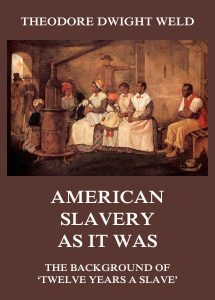American Slavery As It Was – The Background Of Twelve Years A Slave – Theodore Dwight Weld
With the recent success of the movie and book “Twelve Years A Slave” in mind, this title, as the name imports, gives a true picture of the state of slavery in the United States in the first half of the 19th century. It had an important bearing on the great controversy upon this subject at the time it was published. The evidence which it contains is minutely circumstantial. A considerable portion of the book consists of the narratives of persons who have resided at the south, and witnessed the treatment of the slaves on the plantation with which they were conversant. With very few exceptions the name of the witness is given, and in the cases in which circumstances make it unsafe that he should be known, his character for integrity is vouched for by some responsible person. In some instances also, but those very few, the witness relates what was told him by persons on whose veracity he could rely. But the great mass of the evidence is original and from known and named witnesses. Please be advised that this book contains very explicit and detailed narratives that tell of torture, pain and cruelty.
Format: Paperback.
American Slavery As It Was – The Background Of Twelve Years A Slave.
ISBN: 9783849673642.
Available at amazon.com and other venues.
Basics on slavery in the United States (from Wikipedia):
Slavery in the United States was the legal institution of human chattel enslavement, primarily of Africans and African Americans, that existed in the United States of America in the 18th and 19th centuries after it gained independence and before the end of the American Civil War. Slavery had been practiced in British America from early colonial days, and was legal in all Thirteen Colonies at the time of the Declaration of Independence in 1776.
By the time of the American Revolution (1775–1783), the status of slave had been institutionalized as a racial caste associated with African ancestry. When the United States Constitution was ratified (1789), a relatively small number of free people of color were among the voting citizens (male property owners). During and immediately following the Revolutionary War, abolitionist laws were passed in most Northern states and a movement developed to abolish slavery. Most of these states had a higher proportion of free labor than in the South and economies based on different industries. They abolished slavery by the end of the 18th century, some with gradual systems that kept adults as slaves for two decades. However, the rapid expansion of the cotton industry in the Deep South after the invention of the cotton gin greatly increased demand for slave labor, and the Southern states continued as slave societies. Those states attempted to extend slavery into the new Western territories to keep their share of political power in the nation; Southern leaders also wanted to annex Cuba to be used as a slave territory. The United States became polarized over the issue of slavery, represented by the slave and free states, in effect divided by the Mason–Dixon line which delineated (free) Pennsylvania from (slave) Maryland and Delaware.
Congress during the Jefferson administration prohibited the importation of slaves, effective 1808, although smuggling (illegal importing) was not unusual.Domestic slave trading, however, continued at a rapid pace, driven by labor demands from the development of cotton plantations in the Deep South. More than one million slaves were sold from the Upper South, which had a surplus of labor, and taken to the Deep South in a forced migration, splitting up many families. New communities of African-American culture were developed in the Deep South, and the total slave population in the South eventually reached 4 million before liberation.
As the West was developed for settlement, the Southern state governments wanted to keep a balance between the number of slave and free states to maintain a political balance of power in Congress. The new territories acquired from Britain, France, and Mexico were the subject of major political compromises. By 1850, the newly rich cotton-growing South was threatening to secede from the Union, and tensions continued to rise. Many white Southern Christians, including church ministers, attempted to justify their support for slavery as modified by Christian paternalism. The largest denominations, the Baptist, Methodist, and Presbyterian churches, split over the slavery issue into regional organizations of the North and South. When Abraham Lincoln won the 1860 election on a platform of halting the expansion of slavery, seven states broke away to form the Confederacy. The first six states to secede held the greatest number of slaves in the South. Shortly after, the Civil War began when Confederate forces attacked the US Army’s Fort Sumter. Four additional slave states then seceded. Due to Union measures such as the Confiscation Acts and Emancipation Proclamation in 1863, the war effectively ended slavery, even before ratification of the Thirteenth Amendment in December 1865 formally ended the legal institution throughout the United States.
(The text of the last section was taken from a Wikipedia entry and is available under the Creative Commons Attribution-ShareAlike License.)
Publisher’s Note: This book is printed and distributed by Createspace a DBA of On-Demand Publishing LLC and is typically not available anywhere else than in stores owned and operated by Amazon or Createspace.

